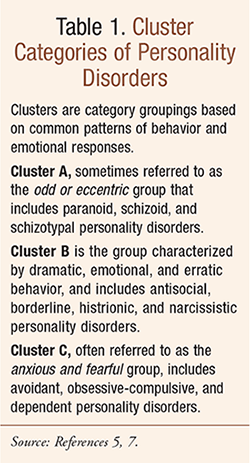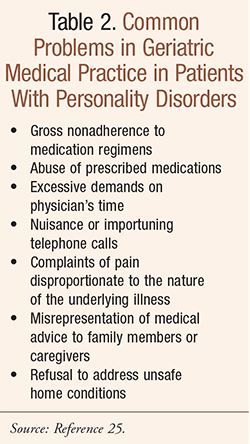In the current healthcare landscape, adherence to disease state management, including medication therapy, ranks high on the list of priorities that healthcare systems are homing in on to keep patients from being readmitted to the hospital. But what if a particular personality trait lends itself to nonadherence to medical and medication therapy? And what if this personality trait presents in some individuals to the extent that it is deemed a pathologic disorder? Borderline personality disorder (BPD) is one such condition that pharmacists and other healthcare providers need to be aware of.
Current data indicate that an estimated 18 million Americans will develop BPD in their lifetime.1 The median population prevalence of BPD is approximately 1.6%, but may be as high as 5.9%. It is estimated that the prevalence of BPD is 6% in the primary care setting, 10% among mental-health outpatients, and about 20% among psychiatric inpatients; among the elderly, estimates are lower.2 Symptoms of this disorder can be severe, debilitating, and isolating; further, patients are subjected to discrimination and bias. BPD can adversely impact the patient’s familial and personal relationships, employment, and overall functioning. There are significant personal and social costs of BPD that are not limited to those who have been diagnosed with the disorder, but extend to children, spouses, siblings, and parents who are all affected by their loved one’s illness.1
Given that a large proportion of the population is directly affected by BPD, either by a diagnosis of it, or by living or closely interacting with someone who has the disorder, it has been deemed by policy makers in healthcare and government that developing awareness of and services for this complex illness is imperative for both individual and public health. In 2011 the Substance Abuse and Mental Health Services Administration (SAMHSA) of the U.S. Department of Health and Human Services developed an overview of BPD and recommendations for expanding early detection, evidence-based treatment, and family education to promote resilience and recovery for individuals diagnosed with the disorder.1 In 2013, the revised Diagnostic and Statistical Manual of Mental Disorders Fifth Edition (DSM-5), which extensively outlines personality disorders including BPD, was revised.5 Those publications are additional current resources to the American Psychiatric Association’s (APA) Practice Guideline for the Treatment of Patients with Borderline Personality Disorder from 2001, and the 2005 Guideline Watch, which highlighted newer developments since the original APA guideline.3,4 Pharmacists are encouraged to refer to these sources—in the context of evolving information—for guidance beyond the scope of this article.
Personality Disorders
Personality disorders continue to rank among the most frustrating and difficult types of psychiatric conditions presenting to the clinician. Levels of heritability are about 50%, which is similar to or higher than that of many other major psychiatric disorders.2 The DSM-5 defines a personality disorder as an enduring pattern of inner experience and behavior that deviates markedly from the expectations of the individual’s culture, is pervasive and inflexible, has an onset in adolescence or early adulthood, is stable over time, and leads to distress or impairment.5 The patient’s traits are marked enough to impair interpersonal functioning and the ability to maintain employment or function in society.2,6 These maladaptive patterns of coping with the relationships, experiences, and stressors associated with daily living are chronic, enduring, and not the result of physiological effects of a substance (e.g., prescribed drug, illicit drug) or a general medical condition (e.g., head trauma). In late life, personality disorders may attenuate, reemerge, or even present de novo depending on social context and cluster—the clinically useful grouping of personality disorders based on common patterns of behavior and emotional responses (Table 1).5,7

Often, personality disorders are comorbid with mood, anxiety, substance abuse, somatization, and eating disorders; when these comorbidities are present, a significantly worse prognosis and a lower likelihood of response to treatment is expected.2 Rates of personality disorder in studies of geriatric populations appear to be highest in patients with depression, about 31% of those with either major depression or dysthymia.8 In the elderly, in whom multimorbidity occurs in more than half of the population, personality disorders may substantially complicate the course and treatment of comorbidities and adversely affect quality of life.9,10 Problems commonly encountered in geriatric medical practice in patients with personality disorders (Table 2) include gross nonadherence to and abuse of medication regimens, complaints of pain disproportionate to the nature of the underlying illness, and misrepresentation of medical advice to family members.11

Borderline Personality Disorder
BPD is one of 10 specific personality disorders (see Reference 5) and is defined as a pattern of marked impulsivity and instability in interpersonal relationships, self-image, and affect. In the clinical setting, but not in the general population, women outnumber men 3 to 1.2 BPD is commonly seen in all medical and psychiatric settings, and problems associated with these patterns of behavior continue into late life. 2,6
Clinical Presentation: Importantly, patients with this disorder lack a true sense of self, which translates into impairment of self-regulating abilities as a consequence.12,13 Patients with BPD look outside of themselves for directions, evaluations, opinions, or rules to guide them instead of looking within themselves to locate feelings or to make decisions.12,13
Patients with BPD are hypersensitive to environmental situations. With a tendency to believe that they were deprived of appropriate care during their childhood, they feel empty, angry, and entitled to nurturing, which provokes relentless care-seeking behavior and sensitivity to its perceived absence. Relationships with these individuals are intense and dramatic owing to feelings fluctuating from needing to be cared for (i.e., when they appear like lonely waifs) to fear of loss of the caring person (i.e., when they express inappropriate and intense anger).2 Impulsivity may involve potentially self-damaging behavior (e.g., issues with spending and sex, substance abuse, reckless driving, binge eating) and somatic complaints are common.2 In addition to irritability and emotional hypersensitivity, patients with BPD exhibit symptoms of anxiety and depression.
Suicide Risk and Caregiver Burden: Typically, a person with BPD will experience mood changes involving extreme shifts in their view of the world, themselves, and other people (e.g., from bad to good, from hated to loved).2 While feelings of self-hatred often provoke self-harm, feelings of abandonment cause the patient to dissociate, have brief psychotic episodes, or become impulsive to the point of desperation, provoking suicidal acts.2 The characteristic unstable emotions, anger, and high rates of suicide associated with BPD can be extremely stressful and burdensome for family members and caregivers.1 Completed suicide occurs in 8%-10% of patients, and acts of self-mutilation (e.g., cutting or burning) and suicide threats and attempts are common.5
The patient with BPD can provoke a specific caregiver response. Initially, the caregiver response to the patient with BPD is an intense nurturing; however, after repeated crises, vague unfounded complaints, and failures to adhere to therapeutic recommendations, the caregiver may respond with negativity and hostility.2 It is important for pharmacists and other clinicians to understand that family members of individuals with a diagnosis of BPD report very high levels of depression, grief, isolation, and hopelessness associated with their loved one’s illness; these individuals may be at risk for developing their own psychiatric problems.14-17
Diagnosis: Personality Trait or Personality Disorder?
Personality disorders are distinguished from personality traits (e.g., sensitivity to criticism) that merely describe a person’s typical style; traits do not reach the threshold for personality disorders. Diagnosis is made only when the patterns of behavior are inflexible, maladaptive, persisting, and cause functional impairment or subjective distress.5 Diagnosing personality disorders in the elderly is a challenging process, owing to the difficulty encountered in distinguishing between functional impairments related to personality and those related to physiological and environmental aspects of aging.11 Available tools for assessing personality disorders do not include one that is ideal for the geriatric patient; the majority are lengthy structured interviews that rely on the self-reporting of behaviors, a process which can be overwhelming to elderly patients.11
The accuracy of diagnosing personality disorders in the elderly has been confounded by questions about the relevance of some personality disorder criteria to the elder-life experience.18 Abrams points out that older adults have less opportunity to manifest impulsivity or recklessness; additionally, dependency can certainly be misinterpreted where a real disability exists.18 Younger patients face a different array of psychosocial challenges (e.g., separating from parents, establishing relationships, functioning in the workplace) than do older adults coping with retirement, loss, and comorbidities. The possible explanation for a large number of “not otherwise specified” (NOS) or mixed personality disorders in some elderly samples is viewed by some to be attributed to age bias involving certain diagnostic criteria.19,20
Abrams and Sadavoy indicate that alternative approaches to assessment of personality disorders in the elderly tend to deemphasize specific diagnostic criteria and past functioning, focusing instead on contemporaneous evidence of an elderly individual’s behavior and quality of interpersonal relationships.21 This approach highlights the manner in which the older adult copes with age-related stresses, especially personal losses, loss of a spouse, and morbidity. These researchers underscore that the patient’s attitudes toward physicians and caregivers are especially important and revealing.21
Therapeutic Management
Integration of psychiatric practitioners within primary care is a component of the national Patient Centered Medical Home initiative. In line with this initiative, the APA’s practice guideline addresses the role of patient preference. The guideline stipulates treatment should be a collaborative process between patient and clinician(s), and patient preference is an important factor to consider when developing an individual treatment plan.3 BPD can be effectively managed by experienced clinicians; those with inexperience may worsen the disorder.2 Of note, the primary target of treatment should be BPD when it occurs with major depressive, panic, bipolar, or eating disorders; BPD is the secondary target when it occurs with substance use disorders.2 Psychosocial and medication therapies are effective for use in reducing suicidality, hospital and emergency department use, and depression.2 Psychosocial treatments, medication therapy, and electroconvulsive therapy (ECT) are treatments used in the management of BPD.
Psychotherapy and Other Psychosocial Treatments are the cornerstone of treatment of BPD. Individual and group psychotherapy, skills training, family psychoeducation, pharmacotherapy, and peer support are among the empirically based interventions for BPD.1 The most widely used is dialectical behavior therapy, a modality based on learning and acquiring new skills to help regulate emotions and behavior, that combines individual and group sessions; therapists act as behavior coaches and are available on call around the clock.2,22 Equally effective is general psychiatric management, which uses individual therapy once a week, and sometimes incorporates medication.
Medication therapy is helpful only in selected cases—for example, to target significant anxiety, angry outbursts, and depression.2 However, treatments become effective only after patients see that their problems are within themselves, not just caused by external factors.2 The APA’s Psychopharmacological Treatment Algorithms for Borderline Personality Disorder can help guide the clinician in targeting the following3:
• Affective dysregulation symptoms
• Impulsive-behavioral dyscontrol symptoms
• Cognitive-perceptual symptoms
Further research is needed to validate this algorithm selection approach.4 Treatment with the following medication categories is covered in these algorithms: selective serotonin reuptake inhibitors (SSRIs); tricyclic and heterocyclic antidepressants; monoamine oxidase (MAO) antidepressants; lithium and anticonvulsant mood stabilizers; anxiolytic agents; opiate antagonists; and neuroleptics. SSRIs, MAO inhibitors, and tricyclic and heterocyclic antidepressants are among those most commonly used.1 For the elderly, SSRIs are typically the antidepressant of choice for diminishing both impulsivity and mood symptoms because of their safety.
The mood stabilizers, particularly topiramate and lamotrigine, may be useful in some patients, particularly for anger management and mood instability.2 According to the APA, owing to the paucity of evidence concerning certain anticonvulsant agents (e.g., gabapentin, lamotrigine, topiramate) in the treatment of BPD, it is recommended that careful consideration of the risks and benefits be considered pending the publication of findings from systematic studies.3,23 Further, lithium carbonate and the mood stabilizers carbamazepine and divalproex may be useful in treating behavioral dyscontrol and affective dysregulation in some patients with BPD, although further studies are needed.3
Antipsychotics may help alleviate obsessive ruminations, somatic complaints, and dissociative experiences; caution is advised when benzodiazepines are included in hospice standing orders, as they aggravate symptoms of hostility and impulsiveness.
Pharmacists are encouraged to note specific dosing recommendations, special considerations, and appropriate monitoring parameters for the geriatric patient (see Reference 24) when recommending the use of these agents, and others mentioned above, in the elderly. It should be kept in mind that elderly patients are particularly prone to certain medication side effects (e.g., orthostatic hypotension and anticholinergic effects) and therefore may tolerate certain medications less well than younger adults.4 Ongoing monitoring and reassessing the clinical status and treatment plan of the patient with BPD is imperative. Periodic setbacks at times of stress are to be expected; however, this should not block ultimate improvement with therapy.
According to the APA Work Group on Borderline Personality Disorder, many aspects of pharmacotherapy regarding the treatment of BPD require investigation, including a need for further controlled treatment studies of medications, particularly those that have received relatively little investigation, such as the atypical antipsychotic agents.3 This expert work group indicates that studies are also needed regarding continuation and maintenance treatment and treatment discontinuation, as well as systematic studies of treatment sequences and algorithms.3
Prognosis
Contributions to high rates of remission of BPD over time include diminished impulsivity with increased age.26 While BPD is likely to remit—and once it does, it usually does not relapse—the reduction in symptoms is not associated with a comparable improvement in social functioning.2 Only 20% of patients with BPD have stable relationships or full-time employment after 10 years of therapy.2 Despite the frequent severity of BPD symptoms and the extremely high rate of suicide and self-injury, this diagnosis has a very positive prognosis.1
Conclusion
BPD is often difficult to treat, and may substantially complicate the course and treatment of comorbidities, especially in the elderly. Given the chronic nature of this disorder, pharmacists must consider the likelihood of gross nonadherence to medication regimens in elderly patients with BPD. While this disorder may adversely affect quality of life, BPD has a good long-term prognosis with a high rate of recovery.1 As expert consensus has reported, awareness, education, and access to treatment and services are critical to ensuring that individuals with BPD and their families and caregivers have the tools and support they need for wellness.
REFERENCES
1. U.S. Department of Health and Human Services, Substance Abuse and Mental Health Services Administration. Report to Congress on borderline personality disorder. May 2011. http://store.samhsa.gov/product/Report-to-Congress-on-Borderline-Personality-Disorder/SMA11-4644. Accessed October 20, 2014.
2. Personality disorders. Psychiatric disorders. The Merck Manual. Last full revision May 2012; last modified November 2013. www.merckmanuals.com/professional/psychiatric_disorders/personality_disorders
personality_disorders.html?qt=borderline personality disporder&alt=sh. Accessed October 10, 2014.
3. American Psychiatric Association. Practice guideline for the treatment of patients with borderline personality disorder. Am J Psychiatry. 2001; 158:1–52. http://psychiatryonline.org/pdfaccess.ashx?ResourceID=243177&PDFSource=6. Accessed October 22, 2014.
4. Oldham JM. Guideline Watch: Practice Guideline for the Treatment of Patients with Borderline Personality Disorder. Arlington, VA: American Psychiatric Association; 2005. http://psychiatryonline.org/pdfaccess.ashx?ResourceID=243174&PDFSource=6. Accessed October 22, 2014.
5. American Psychiatric Association. Diagnostic and Statistical Manual of Mental Disorders, Fifth Edition (DSM-5). 2013:645-684.
6. Lantz MS. Personality disorders in late life: dealing with difficult and demanding patients. Clin Geriatr. 2006;14:12-16.
7. Sadavoy J, Fogel B. Personality disorder in old age. In: Birren JE, Sloane RB, Cohen GD, eds. Handbook of Mental Health and Aging. 2nd ed. San Diego, CA: Academic Press;1992:433-462.
8. Devanand DP, Turret N, Moody BJ, et al. Personality disorders in elderly patients with dysthymic disorder. Am J Geriatr Psychiatry. 2000;8:188-195.
9. Patient-centered care for older adults with multiple chronic conditions: a stepwise approach from the American Geriatrics Society. American Geriatrics Society Expert Panel on the Care of Older Adults With Multimorbidity. J Am Geriatr Soc. 2012:60:1957-1968.
10. Abrams RC, Alexopoulos GS, Spielman LA, et al. Personality disorder symptoms predict declines in global functioning and quality of life in elderly depressed patients. Am J Geriatr Psychiatry. 2001;9:67-71.
11. Abrams RC, Bromberg CE. Personality disorders in the elderly. Psychiatr Ann. 2007; 37:123-127.
12. Landesman A. Mahler’s developmental theory: training the nurse to treat older adults with borderline personality disorder. J Geront Nurs. 2003;29:22-28,54-55.
13. Hill R. End-of-life care for the patient with borderline personality disorder. J Hosp Palliat Nurs. 2005;7:150-162.
14. Buteau E, Dawkins K, Hoffman P. In their own words: improving services and hopefulness for families dealing with BPD. Soc Work Ment Health. 2008;6:203-214.
15. Fruzzetti AE, Shenk C, Hoffman PD. Family interaction and the development of borderline personality disorder: a transactional model. Dev Psychopathol. 2005;17:1007-1030.
16. Hartman D, Boerger MJ. Families of borderline clients: opening the door to therapeutic interaction. Perspect Psychiatr Care. 1990;25:15-17.
17. Hoffman PD, Buteau E, Hooley JM, et al. Family members’ knowledge about borderline personality disorder: correspondence with their levels of depression, burden, distress, and expressed emotion. Fam Process. 2003;42:469-478.
18. Abrams RC. The aging personality [editorial]. Int J Geriatr Psychiatry. 1991;6:1-3.
19. Stone MH. Long-term outcome in personality disorders. Br J Psychiatry. 1993;162:229-313.
20. Abrams RC, Horowitz SV. Personality disorders after age 50: a meta-analytic review of the literature. In: Rosowsky E, Abrams RC, Zweig R, eds. Personality Disorders in Older Adults: Emerging Issues in Diagnosis and Treatment. Mahwah, NJ: Lawrence Erlbaum Associates; 1999:55-68.
21. Abrams RC, Sadavoy J. Personality disorders. In: Sadavoy J, Jarvik LF, Grossberg GT, Meyers BS,eds. Comprehensive Textbook of Geriatric Psychiatry. 3rd ed. New York, NY: WW Norton and Co; 2004:701-721.
22. Clarkin JF, Levy KN, Lenzenweger MF, et al. Psychotherapy for borderline personality disorder. Am J Psychiatry. 2007;164:922-928. www.medscape.com/viewarticle/563986#vp_2. Accessed October 10, 2014.
23. Pinto OC, Akiskal HS. Lamotrigine as a promising approach to borderline personality: an open case series without concurrent DSM-IV major mood disorder. J Affect Disord. 1998; 51:333-343.
24. Semla TP, Beizer JL, Higbee MD. Geriatric Dosage Handbook. 19th ed. Hudson, OH: Lexicomp; 2014.
25. Abrams RC, Bromberg CE. Personality disorders in the elderly: a flagging field of inquiry. Int J Geriatr Psychiatry. 2006;21:1-6.
26. Stevenson J, Meares R, Comerford A. Diminished impulsivity in older patients with borderline personality disorder. Am J Psychiatry. 2003; 160:165-166.
To comment on this article, contact rdavidson@uspharmacist.com.





